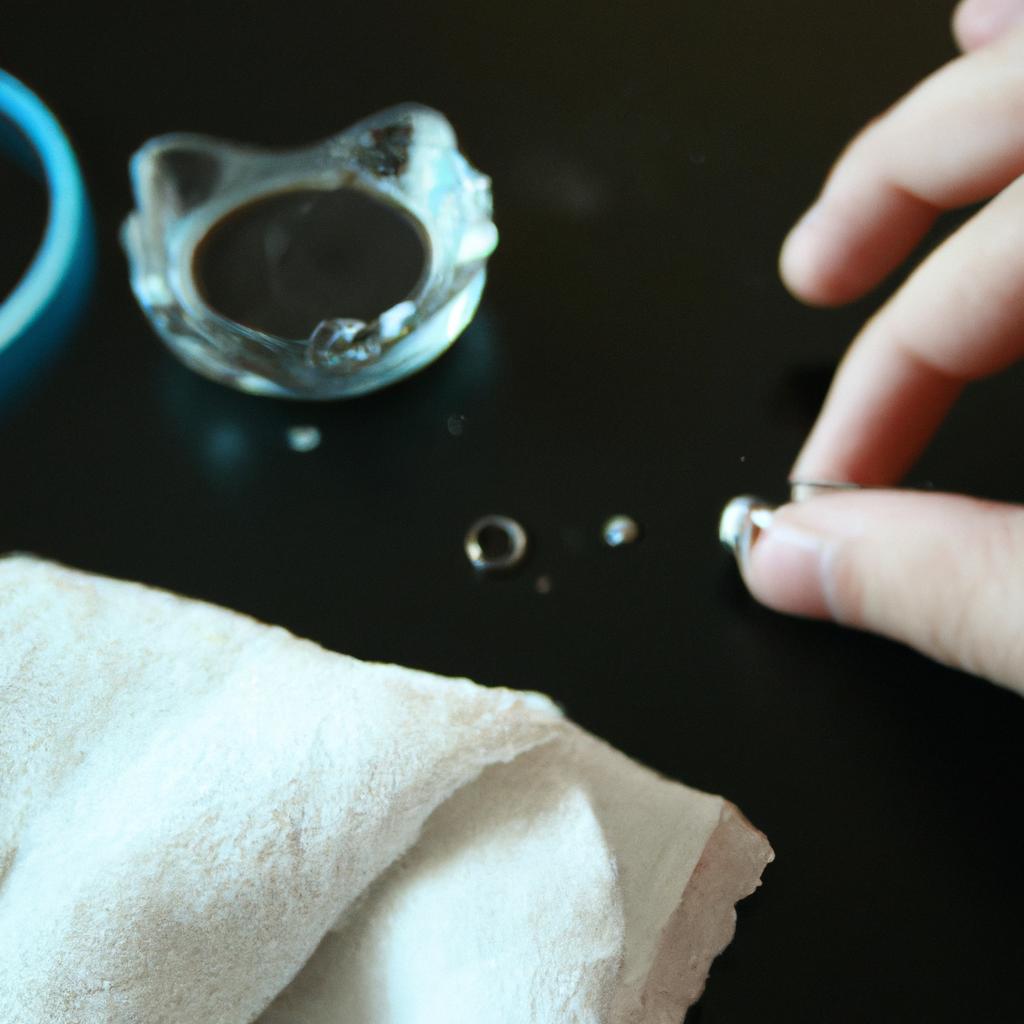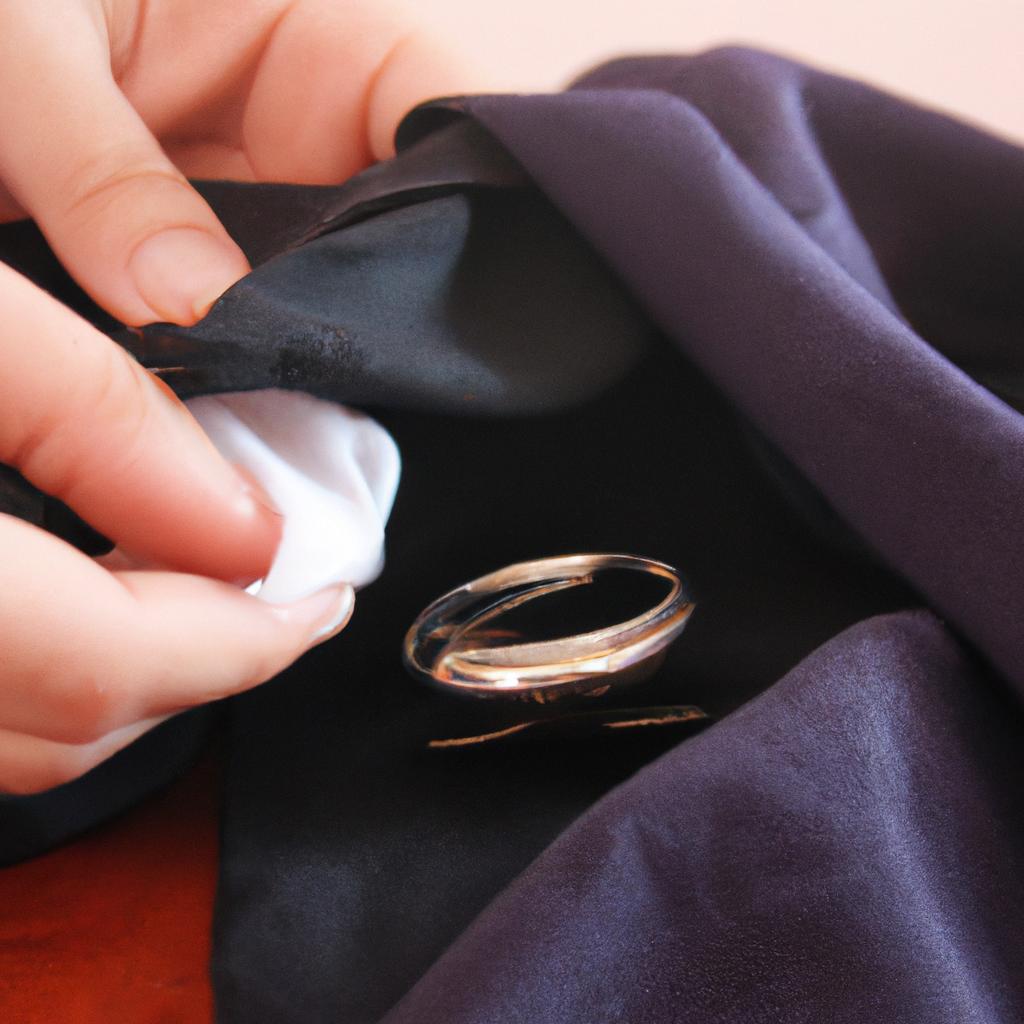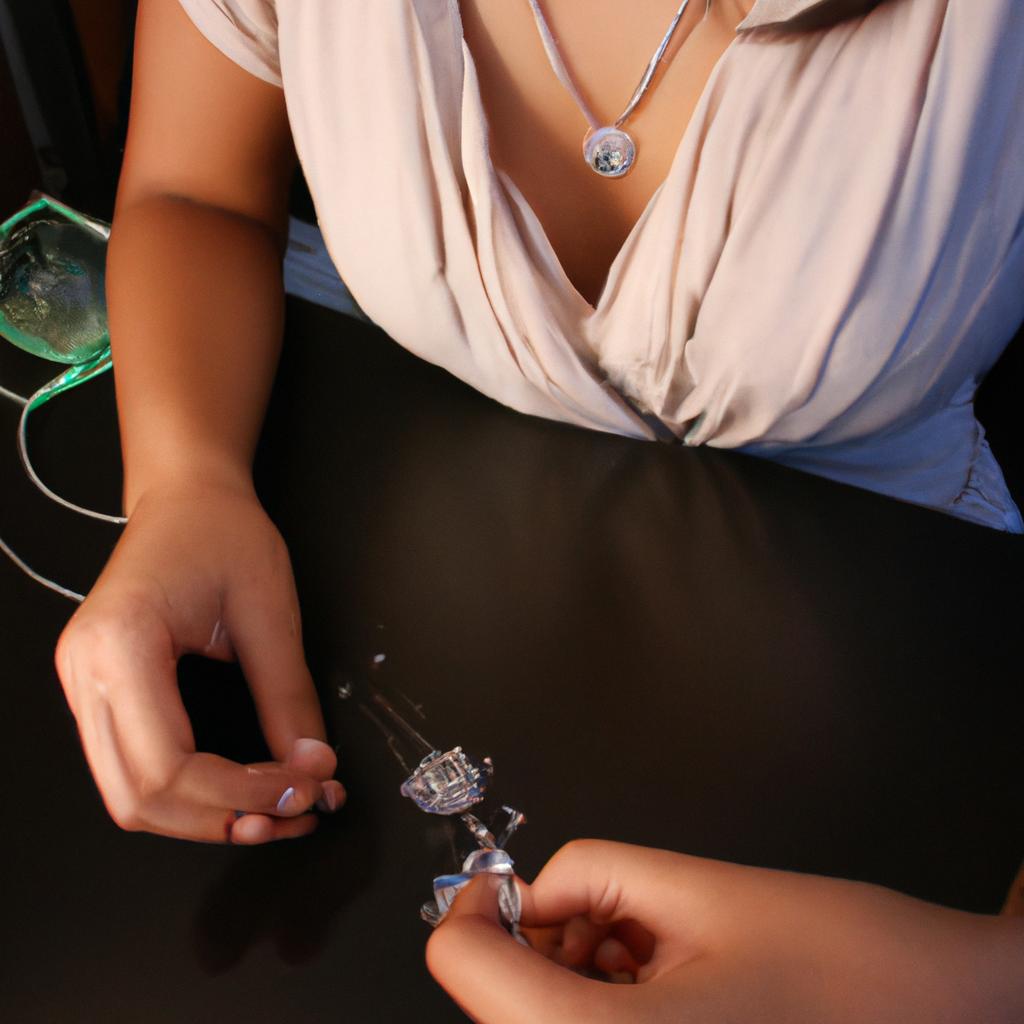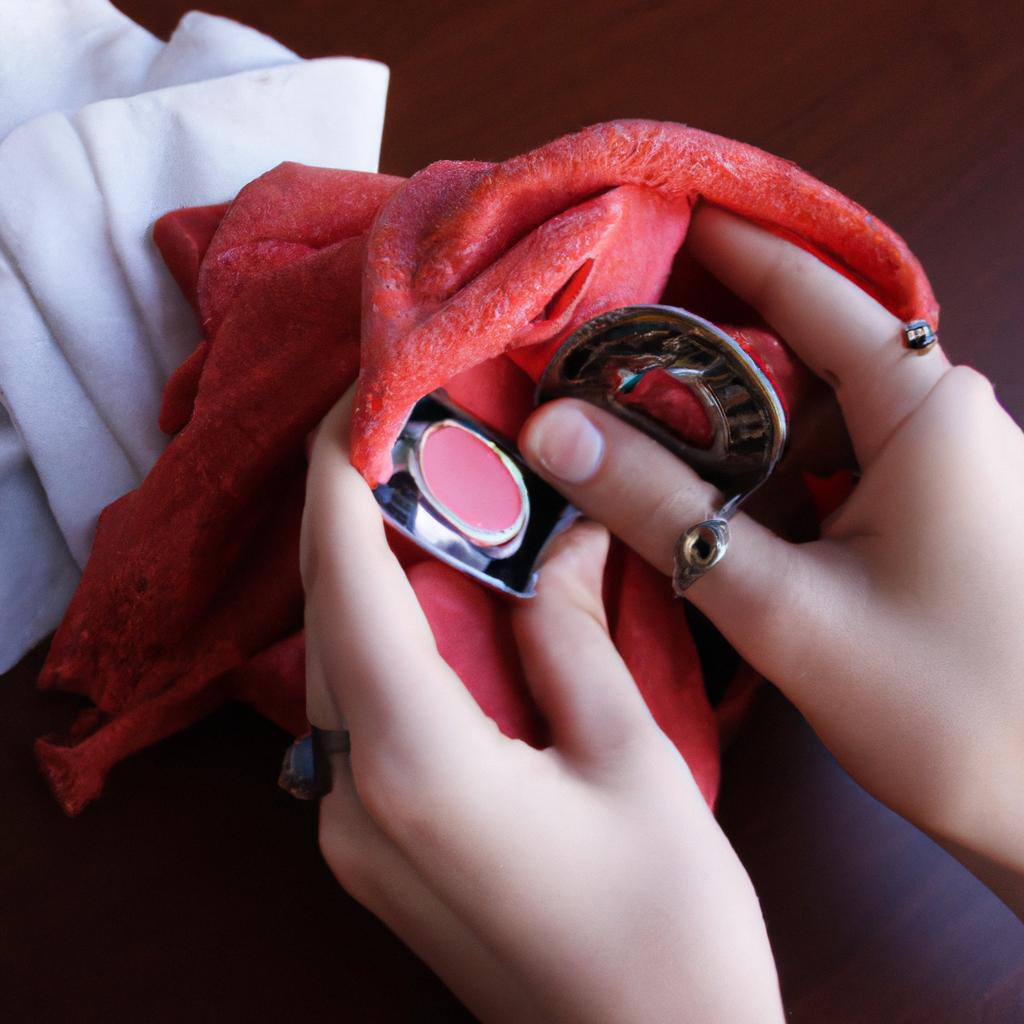The longevity and aesthetic appeal of jewelry heavily rely on proper care and maintenance. Over time, even the finest pieces can succumb to wear and tear, leaving owners with the task of restoring their precious treasures. This article aims to provide a comprehensive overview of repair methods in jewelry care, highlighting essential techniques that can be employed for maintaining and restoring various types of jewelry.
Consider the case of an antique diamond ring passed down through generations—a cherished family heirloom. Despite its sentimental value, years of use have resulted in loose prongs and a worn-out band. In such instances, appropriate repair methods become paramount in order to ensure the continued integrity and beauty of this beloved piece. By understanding different techniques available for repairing jewelry, individuals can take proactive measures towards preserving not only sentimental attachments but also monetary investments tied to these valuable possessions.
This article will delve into fundamental concepts surrounding jewelry repair, including common issues encountered by enthusiasts and professionals alike. Techniques such as soldering, stone replacement, polishing, and restringing will be explored in detail, shedding light on their respective applications within the context of jewelry restoration. By equipping readers with knowledge about these key repair methods, they will be better prepared to address any deterioration or damage that may arise throughout the lifespan of their tre asures.
Soldering is a crucial technique in jewelry repair, especially when it comes to fixing loose or broken metal components. It involves using a high-temperature torch to heat the metal and apply solder, which acts as a bonding agent to join the pieces together. This method can be used to reattach prongs, mend broken chains, or fix clasps and jump rings. However, it requires skill and precision to ensure that the repair is seamless and does not damage any gemstones or delicate elements of the piece.
Stone replacement is another common repair method for jewelry that has missing or damaged gemstones. Whether it’s a diamond in an engagement ring or a colored gemstone in a pendant, replacing stones can breathe new life into a piece. Jewelers carefully select stones that match the original in terms of size, color, and quality. The old stone is removed, and the new one is securely set in place using techniques like prong setting or bezel setting.
Polishing plays a vital role in restoring the luster and shine of jewelry. Over time, metals like gold and silver can become tarnished or develop scratches due to regular wear. Polishing involves using specialized tools and compounds to remove surface imperfections and bring back the gleam of the metal. This technique requires caution as excessive polishing can remove valuable patina or alter the design details of antique pieces.
Restringing is primarily used for repairing necklaces and bracelets made from beads or pearls. With time, stringing materials may weaken or break, leading to potential loss of beads. Restringing involves removing all existing beads from the damaged strand and meticulously threading them onto a new string with appropriate knots between each bead for security. This ensures that the piece remains intact while also enhancing its durability.
In conclusion, understanding various repair methods is essential for maintaining and restoring jewelry’s longevity and aesthetic appeal. Soldering allows for secure connections between metal components, stone replacement breathes new life into pieces with missing or damaged gemstones, polishing revitalizes the shine of metals, and restringing ensures the durability of beaded or pearl jewelry. By familiarizing themselves with these techniques, individuals can take proactive measures to preserve their precious treasures for generations to come.
Cleaning and Polishing
Imagine you stumble upon a beautiful antique necklace that has been passed down through generations. As you hold it in your hands, you notice the dullness of its once lustrous surface. This is where cleaning and polishing techniques come into play, essential methods for maintaining and restoring the beauty of your precious jewelry.
To begin the process, one effective method involves using a mild detergent solution combined with warm water. Gently immerse the piece in this mixture and use a soft-bristled brush to remove any dirt or debris. Be cautious not to scrub too vigorously, as this may scratch delicate gemstones or metals. After rinsing thoroughly with clean water, pat dry with a lint-free cloth.
Once cleaned, it’s time to restore the shine of your jewelry through the art of polishing. A tried-and-true approach is to apply jeweler’s rouge onto a soft cotton cloth and gently rub it onto the surface in circular motions. This will help remove tarnish and bring back the brilliance of metals such as silver or gold. For more intricate pieces, consider investing in an ultrasonic cleaner – a device that uses high-frequency sound waves to generate tiny bubbles which effectively lift away grime from hard-to-reach areas.
Now let’s explore how these cleaning and polishing techniques can evoke an emotional response when caring for your treasured possessions:
- Restoring Sentimental Value: By taking care of your jewelry through proper maintenance techniques, you are preserving more than just their physical appearance; you are safeguarding cherished memories associated with each piece.
- Enhancing Self-Confidence: Wearing clean and polished jewelry boosts confidence by allowing individuals to showcase their personal style effortlessly.
- Reviving Family Heirlooms: The act of carefully cleaning and polishing family heirlooms ensures they continue to be enjoyed by future generations while honoring ancestral heritage.
- Cultivating Appreciation: Through regular cleaning and polishing rituals, you develop a deeper understanding and appreciation for the craftsmanship and artistry that went into creating each piece.
Additionally, consider referring to this table as a quick reference guide when choosing appropriate cleaning methods based on different jewelry materials:
| Jewelry Material | Cleaning Method |
|---|---|
| Gold & Silver | Mild Detergent Solution + Jeweler’s Rouge |
| Diamond & Gemstones | Mild Detergent Solution + Soft-Bristled Brush |
| Pearls | Gentile Wipe with Clean Cloth |
| Platinum | Ultrasonic Cleaner |
As you can see, cleaning and polishing play an integral role in preserving the beauty and longevity of your precious jewelry. By following these techniques, you not only maintain their allure but also ensure they continue to hold emotional significance throughout time.
Transitioning seamlessly into the subsequent section about “Stone Setting and Prong Repair,” we delve into further aspects of maintaining your jewelry’s integrity.
Stone Setting and Prong Repair
Building upon the foundation of cleaning and polishing, we now delve into stone setting and prong repair. This crucial aspect of jewelry care ensures that gemstones are securely held in place, preserving both their aesthetic appeal and monetary value. Let us explore the essential techniques involved in this intricate process.
Stone setting involves carefully placing gemstones within a piece of jewelry to showcase their brilliance while ensuring they remain firmly fixed. Consider a hypothetical scenario where a jeweler is tasked with resetting an exquisite diamond ring after one of its prongs became loose due to wear and tear. The skilled artisan would meticulously assess the condition of each prong before delicately bending it back into position using specialized tools such as pliers or tweezers. By securing the diamond snugly within its setting, the jeweler restores not only the piece’s elegance but also provides peace of mind for its wearer.
To better understand the intricacies of stone setting and prong repair, let us consider four key aspects:
- Prong Inspection: Thoroughly examining each prong for signs of damage or weakness is paramount. This step allows jewelers to identify any potential issues before they cause further harm.
- Prong Re-tipping: In cases where a prong has worn down significantly or has become thin over time, re-tipping becomes necessary . This technique involves adding additional metal to rebuild and strengthen weakened areas.
- Bezel Setting: An alternative method to traditional prongs, bezel settings involve encircling the entire circumference of a gemstone with small strips of metal. This technique offers enhanced security while maintaining a sleek appearance.
- Channel Setting: Often used for smaller stones in bracelets or wedding bands, channel settings involve creating narrow tracks between two parallel lines of metal which hold multiple gemstones simultaneously.
Furthermore, understanding these techniques can be aided by referring to the following table:
| Technique | Description | Advantages |
|---|---|---|
| Prong Re-tipping | Adding metal to worn or weak prongs for enhanced support | – Restores strength to weakened prongs |
| Bezel Setting | Encircling a gemstone with metal strips | – Provides maximum security |
| Channel Setting | Creating tracks between parallel lines of metal | – Ideal for showcasing multiple small stones |
| Incorporating these techniques effectively ensures the longevity and beauty of your treasured jewelry. By mastering stone setting and prong repair, you can safeguard against potential damage and enjoy your pieces with confidence. |
As we conclude our exploration into the world of stone setting and prong repair, let us now turn our attention towards another vital aspect of jewelry maintenance: soldering and metal repair
Soldering and Metal Repair
Imagine you have a cherished heirloom ring that has been passed down through generations. One day, you accidentally drop it on a hard surface, causing the delicate band to break in two places. In this section, we will explore soldering and metal repair techniques that can help restore your beloved jewelry pieces to their former glory.
Soldering Techniques:
One of the most common methods used for joining metal parts together is soldering. This process involves melting a filler material called solder onto the broken or damaged areas, creating a strong bond once cooled. There are different types of solders available, such as hard, medium, and easy flowing solders, each with its own specific application based on the type of metal being repaired.
To ensure successful soldering and metal repair, consider the following:
- Cleanliness: Before beginning any repairs, make sure the surfaces to be joined are thoroughly cleaned and free from dirt, oils, and oxides.
- Flux Application: Applying flux helps remove oxidation during heating and promotes better adhesion between the metal surfaces.
- Heat Control: Proper temperature control is crucial to avoid overheating or discoloration of the surrounding areas.
- Finishing Touches: After completing the repair work, sanding and polishing the affected area will help blend the newly repaired portion with the rest of the piece seamlessly.
Table: Common Types of Solders Used in Jewelry Repair
| Type | Melting Point | Applications |
|---|---|---|
| Hard Solder | Above 600°C (1112°F) | Joining precious metals like gold |
| Medium Solder | Around 700°C (1292°F) | Suitable for silver-based alloys |
| Easy Solder | Below 400°C (752°F) | Ideal for repairing base metals |
By mastering soldering and metal repair techniques, you can breathe new life into damaged jewelry pieces. Whether it’s rejoining a broken necklace chain or fixing a bent earring post, the art of soldering allows for precise repairs that restore both the aesthetic appeal and structural integrity of your beloved adornments.
Moving forward to the next section on “Chain and Clasp Repair,” let’s explore how to address common issues related to these vital components in jewelry.
Chain and Clasp Repair
Restringing and Bead Repair
Imagine you have a treasured pearl necklace that has been passed down through generations in your family. One day, you notice that the string holding the pearls together is starting to fray and weaken. If left unattended, it could result in the loss of precious pearls or even breakage of the entire necklace. This scenario highlights the importance of restringing and bead repair techniques in jewelry care.
When it comes to restringing, there are several methods that can be employed depending on the type of beads used and their condition. It is crucial to carefully assess the integrity of each individual bead before proceeding with any repairs. In cases where only a few beads need replacement, they can be gently removed from the string using specialized tools such as tweezers or needle-nose pliers. A new bead can then be threaded onto a durable cord or silk thread and securely knotted into place.
To maintain an aesthetically pleasing appearance after restringing, proper spacing between beads should be ensured for symmetry and balance. Additionally, incorporating different types of knots (such as French knot or surgeon’s knot) at strategic points along the string helps prevent excessive movement between beads, reducing wear and tear over time.
Here are some key considerations when engaging in restringing and bead repair:
- Use high-quality cords or threads specifically designed for jewelry making to ensure durability.
- For delicate materials like pearls or gemstones, consider using flexible wire instead of traditional strings to provide added strength.
- Regularly check your jewelry for signs of damage or weakness in order to address issues promptly.
- Seek professional assistance if you lack experience or confidence in performing these repairs yourself.
| Pros | Cons |
|---|---|
| Restored aesthetic appeal | Time-consuming process |
| Extends lifespan of valuable pieces | Requires meticulous attention to detail |
| Cost-effective alternative to purchasing new jewelry | Requires specialized tools and materials |
| Preservation of sentimental value | Skill and expertise are necessary for optimal results |
As we’ve seen, restringing and bead repair techniques are essential in preserving the beauty and longevity of your jewelry. By addressing these issues promptly and employing proper methods, you can continue to enjoy your cherished pieces for years to come.
[Engraving and Personalization]
Engraving and Personalization
Imagine you have just received a beautiful piece of jewelry as a gift, but it lacks that personal touch. Whether it’s a necklace, bracelet, or ring, engraving and personalization can add sentimental value and make your precious pieces truly unique. Let’s explore the art of engraving and how it can transform ordinary jewelry into cherished heirlooms.
Engraving is the process of etching designs, initials, names, or messages onto metal surfaces using specialized tools. It requires precision and skill to ensure the desired result is achieved without damaging the piece. One example where engraving can be employed is on wedding rings. Couples often choose to engrave their initials or wedding date inside their rings as a symbol of their love and commitment.
To achieve exquisite engravings on jewelry, several techniques are commonly used:
- Hand Engraving: Skilled artisans use handheld tools such as gravers to meticulously carve intricate patterns directly onto the metal surface.
- Laser Engraving: This modern technique utilizes laser technology to create precise and detailed engravings with great accuracy.
- Computer-Aided Design (CAD): With CAD software, designers can create custom engravings digitally before transferring them onto the jewelry through various methods like direct printing or milling.
- Stone Setting: In some cases, gemstones may also be incorporated into engraved designs for added elegance and flair.
When considering personalizing your jewelry through engraving, keep in mind these four key factors:
- Sentimentality: Choose meaningful words or symbols that hold significance to you or the person who will wear the piece.
- Size and Placement: Consider the size of the item and its design when deciding where to place the engraving for optimal visibility and aesthetic appeal.
- Font Selection: Experiment with different fonts that align with your style preferences while ensuring readability at various sizes.
- Material Compatibility: Different metals respond differently to engraving techniques, so it’s essential to consult a professional who can advise on the best approach for your specific piece.
By incorporating engravings and personalization into your jewelry collection, you can infuse pieces with sentimentality and create lasting memories. The next section will delve into another aspect of jewelry repair: resizing and reshaping, which allows you to adapt your precious pieces to fit perfectly or update their style without compromising their original charm.
Resizing and Reshaping
Having explored the art of engraving and personalization, let us now delve into another crucial aspect of jewelry care – resizing and reshaping. These techniques are often employed to ensure that your precious pieces fit perfectly or regain their original shape if they have been damaged or distorted over time.
Resizing a piece of jewelry involves altering its size while maintaining its integrity and aesthetic appeal. Consider the case of Sarah, who inherited her grandmother’s antique ring but found it too small to wear comfortably. By utilizing professional resizing methods, she was able to adjust the band without compromising its intricate design.
To achieve successful resizing or reshaping, jewelers employ various techniques tailored to each unique piece. Here are some commonly used methods:
- Soldering: This technique involves using a soldering torch to join metal parts together seamlessly.
- Stretching/Compressing: For bands made from malleable metals like gold or silver, stretching or compressing can be done carefully to resize them.
- Addition/Subtraction: By adding or removing sections of metal, jewelers can alter the size of rings or bracelets effectively.
- Laser Technology: Advanced laser technology allows for precise modifications with minimal damage to delicate gemstones and settings.
| Scenario | Emotional Response |
|---|---|
| A couple’s wedding bands no longer fit after many years of marriage | Nostalgia mixed with excitement as they anticipate being able to wear their symbols of love once again |
| A family heirloom bracelet is restored to its original shape after being damaged | Relief and joy as the piece returns to its former glory, preserving memories of past generations |
| A cherished necklace that belonged to a loved one who has passed away is resized to be worn daily | Comfort and connectedness as the wearer feels closer to their departed loved one through the shared sentimentality of the jewelry |
In summary, resizing and reshaping techniques play a vital role in maintaining and restoring precious jewelry. Whether it’s adjusting ring sizes for perfect fit or restoring heirloom pieces, these methods ensure not only physical comfort but also emotional attachment to our treasured possessions.
Remember that consulting professional jewelers with expertise in resizing and reshaping will help preserve both the aesthetic appeal and sentimental value of your jewelry for years to come.
 Shanes Jewelry
Shanes Jewelry



